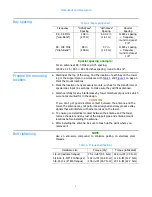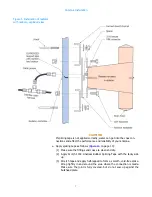
1
Precautions and Preparation
1
Precautions and Preparation
Precautions
WARNING
Don't expose personnel to the medical hazards of intense radio fre-
quency (RF) radiation. Whenever working on the tower in the area of
the antenna, turn off all transmitters and lock them out so that they can-
not be turned on accidentally.
For reference on RF safety, see CFR 29, Section 1910.97, the OSHA standard
(USA only) for exposure to non-ionizing radiation.
In Canada, the equivalent governing authority is Industry Canada.
Before beginning
installation
Storage prior to installation
Keep the antenna system dry. Never store it outdoors. If the antenna gets
wet, you will need to dry it before applying transmitter power.
Check the System
CAUTION
It is YOUR responsibility to ensure that your installation meets all appli-
cable codes and the centerline-of-radiation requirements of your con-
struction permit.
Check the parts to be sure that they will fit the support pipe. Have a reliable
tower person, familiar with antennas and coaxial line, inspect the tower and
review the installation drawings before the full rigging crew arrives. If design
problems are found, contact Shively Labs immediately.
Pay particular attention to:
• Frequency of the antenna.
• Freedom from interference by gussets, leg flanges, guy wires and
their attachment points, tower face members, obstruction lights,
and other components.
• Compatibility of coax connectors and and antenna input terminals.
• Use of non-metallic guy sections on the tower in the region to be
occupied by the FM antenna. Ensure that there are no metal guy
wires within ten feet (three meters) of any radiator.
• Proper electrical service for antenna deicers, if applicable.
• The adequacy of the tower structure and guy wires to carry the
windload placed upon them by the antenna, particularly if radomes
are used.
Storage prior to
installation
Keep the antenna system dry. Never store it outdoors. If the antenna gets
wet, you will need to dry it before applying transmitter power.








































